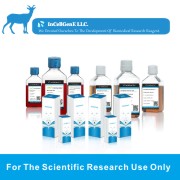

| Organism | Homo sapiens, human |
|---|---|
| Tissue | pancreas |
| Product Format | frozen |
| Morphology | epithelial |
| Culture Properties | adherent |
| Biosafety Level |
1
Biosafety classification is based on U.S. Public Health Service Guidelines, it is the responsibility of the customer to ensure that their facilities comply with biosafety regulations for their own country. |
| Disease | adenocarcinoma |
| Age | 64 years |
| Gender | female |
| Ethnicity | Caucasian |
| Storage Conditions | liquid nitrogen vapor phase |
| Karyotype | modal number = 61 |
|---|---|
| Derivation |
HPAC is a pancreatic adenocarcinoma epithelial cell line derived in 1985 from a nude mouse xenograft of a primary tumor removed from the head of the pancreas of a woman with moderate to well differentiated pancreatic adenocarcinoma of ductal origin.
|
| Clinical Data |
64 years
female
Caucasian
|
| Receptor Expression |
epidermal growth factor (EGF), expressed
glucocorticoid, expressed
epidermal growth factor (EGF); glucocorticoid
|
| Genes Expressed |
HPAC cells are positive for keratin and negative for vimentin and chromogranin A.
|
| Tumorigenic | Yes |
| Effects |
Yes, the cells form tumors in athymic nude mice at the site of inoculation which are histologically similar to the tumor of origin
Yes, the cells have a colony forming efficiency of 64% on plastic and 3.2% in agarose.
|
| Comments |
HPAC proliferation is stimulated by insulin, insulin-like growth factor I (IGF-I), epidermal growth factor (EGF), and transforming growth factor alpha (TGF alpha). Cell growth is suppressed by dexamethasone and other glucocorticoids.
Crude HPAC cell exacts contained significant concentrations of tumor-associated antigens CEA, CA 125, and CA 19-9.
In culture, HPAC cells form monolayers of morphologically heterogenous polar epithelial cells. HPAC is the first reported human pancreatic adenocarcinoma cell line to express a functional glucocorticoid receptor. Immunohistochemical staining revealed that HPAC cells express the pancreatic ductal epithelium marker DU-PAN-2 as well as antigens recognized by the monoclonal antibodies HMFG1 and AUA1. |
| Complete Growth Medium |
A 1:1 mixture of Dulbecco''s modified Eagle''s medium and Ham''s F12 medium containing 1.2 g/L sodium bicarbonate, 2.5 mM L-glutamine, 15 mM HEPES and 0.5 mM sodium pyruvate supplemented with 0.002 mg/ml insulin, 0.005 mg/ml transferrin, 40 ng/ml hydrocortisone, 10 ng/ml epidermal growth factor and 5% fetal bovine serum |
|---|---|
| Subculturing |
Volumes used in this protocol are for 75 cm2 flask; proportionally reduce or increase amount of dissociation medium for culture vessels of other sizes.
Subculture Ratio: 1:3 to 1:6, every 6 to 8 days.
Medium Renewal: 2 to 3 times a week.
Note: For more information on enzymatic dissociation and subculturing of cell lines consult Chapter 10 in Culture of Animal Cells, a manual of Basic Technique by R. Ian Freshney, 3rd edition, published by Alan R. Liss, N.Y., 1994.
|
| Cryopreservation |
Freeze medium: Complete growth medium supplemented with 5% (v/v) DMSO
Storage temperature: liquid nitrogen vapor phase
|
| Culture Conditions |
Temperature: 37��C Atmosphere: Air, 95%; carbon dioxide (CO2), 5% |


